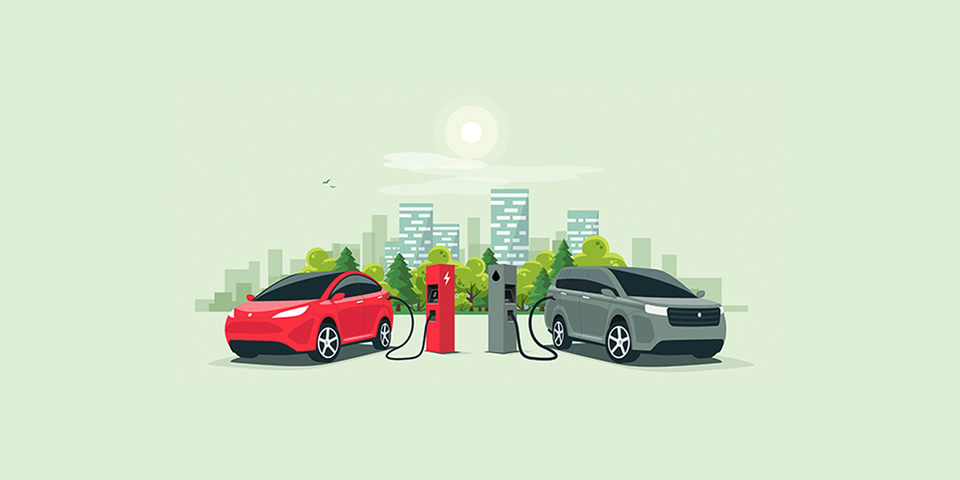Hybrids vs. EVs: The Battle for a Greener Future on Indian Roads

In the pursuit of a cleaner and more sustainable future, electric vehicles (EVs) have gained immense popularity worldwide, and India is no exception. With their promise of zero emissions and reduced long-term costs, many have been drawn to the idea of owning an EV. Car manufacturers in India have recognized this growing trend and have been actively reducing the production of petrol and diesel-powered models while increasing the availability of EVs.
However, a recent study by the Indian Institute of Technology, Kanpur, challenges the notion that EVs are the ultimate solution to our environmental and economic concerns. Surprisingly, the study suggests that hybrids, which combine an electric battery with an internal combustion engine (ICE) that runs on fossil fuels, might actually be a better option for the Indian context.
The researchers conducted simulations based on a car's 10-year lifespan and assumed it would run 20,000 kilometers per year. They analyzed emissions through the entire life cycle, considering factors from production to maintenance and recycling. The results were intriguing: EVs emitted 187 grams of carbon dioxide per kilometer (gCO eq./km), while hybrids emitted only 167 gCO eq./km. Surprisingly, traditional petrol cars emitted even more at 244 gCO eq./km.
The explanation lies in the entire life cycle of these vehicles. While EVs have zero tailpipe emissions, the production of their massive batteries requires significant amounts of nickel, cobalt, and lithium, emitting substantial greenhouse gases. Moreover, charging EVs in India, where 80% of electricity comes from burning coal, increases CO2 emissions.
Hybrids, on the other hand, use a smaller battery, resulting in fewer scarce metals and reduced emissions from mining and processing. They do not require constant plugging into a power source; their batteries are charged when braking, contributing to enhanced mileage. Additionally, India's increasing use of ethanol-blended fuel has shown promise in reducing emissions for hybrid vehicles.
When comparing costs, considering factors like the initial price, annual maintenance charges, and fuel or electricity costs, the analysis reveals that the Total Cost of Ownership (TCO) per kilometer is around ₹13 for both EVs and traditional petrol-powered vehicles. Surprisingly, the TCO for hybrids is ₹14, making them an equally viable option.
However, if the government extends incentives to hybrids similar to those for EVs, the TCO for hybrids could drop even further, potentially making them the clear winner in both environmental impact and cost efficiency.
While this research certainly sparks a debate, it is essential to acknowledge that no analysis is perfect, and circumstances may change in the future. Technological advancements, shifts in energy sources, and fluctuations in fuel prices may alter the equations significantly.
Nonetheless, the study highlights the potential of hybrid vehicles and calls for a closer examination of their role in India's automotive landscape. Currently, hybrid vehicles face relatively higher taxation compared to EVs, deterring potential buyers. Perhaps it is time to reconsider our approach and explore the benefits that hybrids can offer in our journey towards a greener future.
As voices advocating for hybrids grow stronger, it will be intriguing to see how this research impacts the established order in the automotive industry. Hybrids, once considered the stepchild of the market, might just emerge as the frontrunners in our pursuit of a cleaner and sustainable tomorrow.
Frequently Asked Questions (FAQ)
1. What are the main findings of the IIT Kanpur study regarding EVs and hybrids?
The study found that hybrids might be a better option for the Indian context than EVs. Over a 10-year lifespan and 20,000 kilometers per year, hybrids emitted 167 grams of CO2 per kilometer, compared to 187 grams for EVs and 244 grams for traditional petrol cars.
2. Why do hybrids emit less CO2 than EVs according to the study?
Hybrids use smaller batteries, which require fewer scarce metals like nickel, cobalt, and lithium, thus reducing emissions from mining and processing. Additionally, hybrids charge their batteries while braking and use ethanol-blended fuel, which further reduces emissions.
3. What are the environmental implications of producing EV batteries?
The production of EV batteries requires significant amounts of nickel, cobalt, and lithium, which emit substantial greenhouse gases during mining and processing. Moreover, charging EVs in India, where 80% of electricity comes from burning coal, increases CO2 emissions.
4. How does the Total Cost of Ownership (TCO) compare between EVs, hybrids, and traditional petrol vehicles?
The TCO per kilometer is around ₹13 for both EVs and traditional petrol-powered vehicles. For hybrids, the TCO is ₹14. However, if the government extends incentives to hybrids similar to those for EVs, the TCO for hybrids could drop further.
5. Why might hybrids be a more cost-effective option in the future?
If the government provides incentives for hybrids similar to those for EVs, the TCO for hybrids could decrease, making them more cost-effective. Additionally, hybrids do not require constant charging, which can be more convenient and reduce costs associated with electricity.
6. What is the current taxation policy for hybrid vehicles in India?
Hybrid vehicles currently face relatively higher taxation compared to EVs, which deters potential buyers. Adjusting this taxation policy could make hybrids more attractive to consumers.
7. How might technological advancements affect the debate between hybrids and EVs?
Technological advancements, shifts in energy sources, and fluctuations in fuel prices could significantly alter the current findings. As technology evolves, both the environmental impact and cost efficiency of EVs and hybrids could change.
8. What role does the Indian energy mix play in the CO2 emissions of EVs?
Since 80% of India's electricity comes from burning coal, charging EVs significantly increases CO2 emissions. A shift towards greener energy sources could make EVs more environmentally friendly in the future.
9. Why is it important to reconsider the role of hybrids in India's automotive landscape?
The study highlights the potential environmental and cost benefits of hybrid vehicles. Reconsidering the role of hybrids could lead to a more balanced and effective approach to reducing emissions and achieving a greener future.
10. What steps can be taken to promote hybrids in India?
Policymakers could consider extending incentives to hybrids, adjusting the taxation policy, and promoting awareness of the benefits of hybrid vehicles. Encouraging the use of ethanol-blended fuel and investing in technologies that enhance the efficiency of hybrids could also be beneficial.




Member discussion